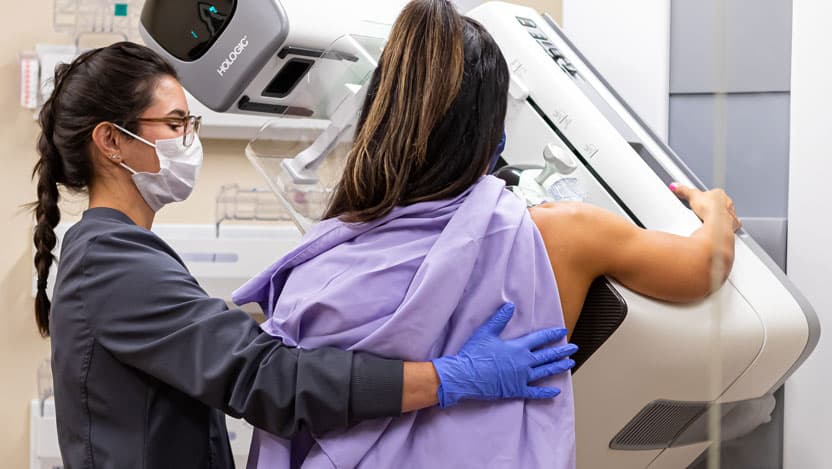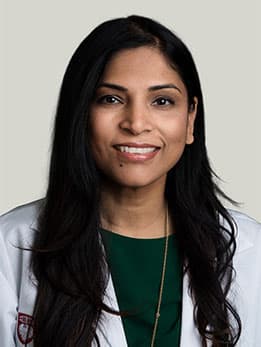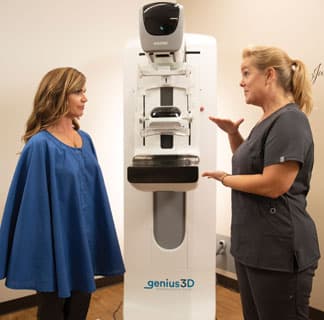Dense breasts and cancer: Tips to empower you and improve your breast health

Standard mammograms are an optimal screening tool to find breast cancer in most patients. When breast radiologists review the mammogram results, they can see the ratio of dense to non-dense breast tissue and assign a category of breast density. If the category is dense breasts, then it’s important for the patient to learn more about the condition, as it increases risk for breast cancer.
What are dense breasts? What is dense breast tissue?
All breasts are made up of glandular tissue and fatty tissue, plus fibrous tissue that holds everything together. Dense breast tissue has a higher proportion of glandular tissue than fatty tissue. This makes it harder to spot problems on mammograms and raises the chances of getting breast cancer.
There are four categories of breast density:
A: Almost entirely fatty, with less than 25% of glandular tissue.
B: Scattered areas of fibroglandular density, with 25-50% of glandular tissue.
C: Heterogenously dense, with 50-75% of glandular tissue.
D: Extremely dense, with more than 75% of glandular tissue.
Dense breasts are common. About 80% of patients fall into the B or C categories. The denser the breasts, the harder it is for radiologists to spot cancer on a standard mammogram.
How do dense breasts increase breast cancer risk?
People with dense breasts (categories C and D) have a two to four times higher risk of breast cancer than those with less dense breasts (categories A and B). Dense tissue also makes it harder to find cancer on a mammogram.
In a mammogram, non-dense breast tissue appears black and transparent, while dense tissue appears white. Since breast masses and cancerous tumors also appear white, dense tissue can hide them, making breast cancer detection more difficult.
As a result, a mammogram might not be effective for cancer detection, and additional tests may be necessary. Understanding your breast density category is essential for determining the most effective breast cancer screening approach.
Will I be told if I have dense breasts after a mammogram?
Yes. Federal notification laws are sweeping the nation. In Illinois, not only is it required to inform patients that they have dense breasts, but insurance companies are required to cover a supplemental screening exam for patients with dense breast tissue.
If I have dense breasts, what are my options for breast cancer screening?
People with an average risk of breast cancer should start getting annual screening mammograms starting at age 40. Those with dense breasts can benefit from tomosynthesis, which is a 3D mammogram that uses X-rays to collect multiple images of the breast from several angles. The other two options for supplemental screening are a whole breast ultrasound examination or a breast MRI.
What are some of the drawbacks to these different tests?
Many people have anxiety about getting a mammogram because the machine places pressure on the breasts, which can be uncomfortable. We do this to make the breast tissue thinner during the exam.
At some of UChicago Medicine’s mammogram testing sites, we have a newer technology with smart curve paddles and that technology greatly reduces the pressure patients feel during a mammogram.
If all of these tests are covered by insurance in Illinois, which one should I get?
In this era of personalized medicine, we have all these amazing tools and we want to pick the right one for you. Talk to your radiologist about what would be the most appropriate test for you and your risk status. If you already have dense breast tissue on a prior mammogram, you should consider getting a 3D mammogram next time and possibly a whole breast ultrasound or breast MRI. The key is to understand your risks and know that there are tools to perform the correct test for you.
What causes dense breasts and dense breast tissue?
The biggest factors are age and genes. Younger females with estrogen in their body traditionally have denser breast tissue. Also, if your mom had dense breast tissue, you’re more likely to have it. Dense breasts have nothing to do with body weight or build. After menopause, breast density usually decreases as estrogen decreases.
What are the challenges associated with dense breast tissue?
Dense breasts themselves do not cause symptoms. You cannot feel or see breast density without medical imaging. However, dense breast tissue can make it harder to find abnormal tissue, such as lumps or masses, on a mammogram. This is why it’s important to stay vigilant about changes in your breasts and follow recommended screening guidelines.
What are the treatments and management options associated with dense breast tissue?
There is no specific treatment for dense breasts, as it is a natural difference in breast tissue composition. However, managing the related risks means using personalized screening strategies. Supplemental imaging tests, such as 3D mammograms, whole breast ultrasounds, or breast MRIs, can help detect cancer that might be missed on a standard mammogram.
If dense breast tissue turns cancerous, treatment options will depend on the type and stage of the cancer. Common treatments include surgery (such as lumpectomy or mastectomy), radiation therapy, chemotherapy, hormone therapy, and targeted therapies. Advances in personalized medicine also allow for treatments tailored to the specific characteristics of the cancer. Discussing your individual risk factors and screening results with your doctor is essential for early detection and effective treatment planning.
Additionally, preventive measures, such as lifestyle changes or medications, may be appropriate for managing overall breast cancer risk.
Can you figure out on your own if you have dense breasts? Are dense breasts the same as firm breasts?
Unfortunately, that is not possible. Physical examination does not help determine breast density, because dense breasts are not the same as firm breasts. A mammogram is necessary to diagnose dense breast tissue.
How do dense breasts affect self-exams?
Breast self-exams are no different with dense breasts. They are no longer included in the federal guidelines. What matters is getting comfortable with what your breasts feel like. No breast feels the same.
What you’re looking for is a change. If all of a sudden you feel a ball or a mass you’ve never felt before, that’s something you need to bring to the attention of your doctor. This is important because it can make it easier to get breast cancer and harder for doctors to find problems using regular X-ray pictures.

Kirti Kulkarni, MD
Radiologist Kirti Kulkarni, MD, specializes in breast and abdominal imaging. Dr. Kulkarni provides comprehensive screening, diagnostic and interventional procedures for breast health. Additionally, she offers diagnostic imaging and interventional services for patients with abdominal and pelvic disorders.
Learn more about Dr. Kulkarni
A Comfortable Mammogram?
New breast screening technologies, like breast-shaped mammogram paddles and high-speed MRIs, are helping make breast cancer testing more comfortable, accurate and convenient.
Learn more